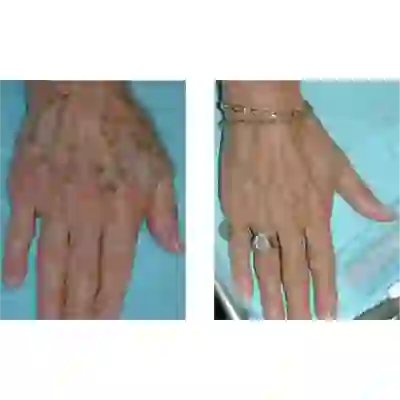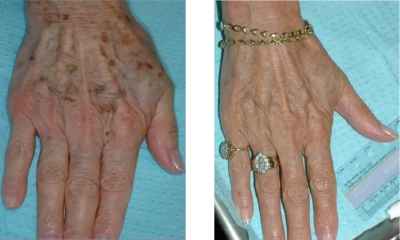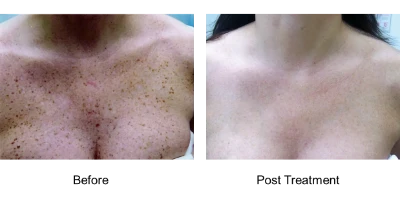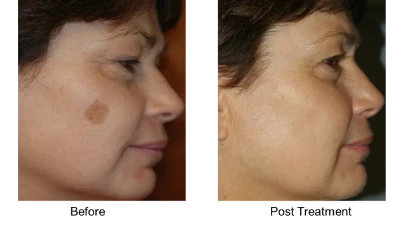
BENIGN PIGMENTED LESION ALBUQUERQUE NM
BENIGN PIGMENTED LESION LASERALBUQUERQUE NM
CALL FOR A FREE CONSULTATION
BENIGN PIGMENTED LESION
WHAT IS A BENIGN PIGMENTED LESION?
Pigmented lesions often involve melanin (brown pigment), resulting in small or large areas of the skin appearing brown, black, or even blue. Although most often benign (harmless), pigmented lesions can also be malignant (cancerous) in some cases.
Benign pigmented lesions can take several different forms, including:
FRECKLES
Freckles are minor flat brown marks arising on the face and other sun-exposed areas. They are most often seen in fair-skinned people, but they are an inherited characteristic that sometimes affects darker skin types. As the person ages, this type of freckle generally becomes more noticeable. It can be lightened by avoiding sun exposure and with the regular use of sunblocks and whitening creams.
They can be safely removed by intense pulsed light therapy (IPL) or pigment laser therapy. We do not offer laser therapy or IPL at present. Still, we can suggest an experienced cosmetic dermatologist/ surgeon who would help you if the above methods are ineffective.
LENTIGINES
More prominent flat brown spots on the face and hands in middle age also result from sun damage exposure. Commonly known as age spots or liver spots, the correct term for a single lesion is solar lentigo (plural lentigines). Lentigines are due to the localized proliferation of melanocytes. It is essential to distinguish the harmless solar lentigo, which does not turn cancerous, from an early malignant melanoma (skin cancer).
Similarly, they can be lightened by avoiding sun exposure and with the regular use of sunblocks and whitening creams. They can also be safely removed by intense pulsed light therapy (IPL) or pigment laser therapy. We do not offer laser therapy or IPL at present. Still, we can suggest an experienced cosmetic dermatologist/surgeon who would help you if the above methods are ineffective.
MELASMA
It appears as a light or dark brown skin discoloration. Melasma can affect anyone, although it is more common in women.
POST-INFLAMMATORY HYPERPIGMENTATION
More common in darker-skinned people, resulting from an injury that stimulates increased melanin production.
SEBORRHOEIC KERATOSES
Seborrhoeic keratosis is superficial skin overgrowth that is brown and slightly raised.Seborrhoeic keratosis is due to aging and sun exposure.Seborrhoeic keratosis can be seen on the face as well as the sun-exposed areas as the limbs. They do not transform into skin cancer. Treatment includes liquid nitrogen and electrocautery.
SKIN TAGS
Skin tags are skin-colored or brown growths that commonly occur on the neck, underarms, and face. They are harmless and do not transform into skin cancer.Skin tags are easily removed by snip-excision and electrocautery.
MOLES
Moles are due to abnormal collections of pigment cells (melanocytes) in the skin. They occur in childhood, adolescents, and early adulthood. Most moles are dark and pigmented. Moles are small, flat, and pigmented when they appear but with aging, they become raised, dome-shaped, and often appear lighter. Moles that develop irregular borders, bleeding, or sudden increase in size cause concern, and a dermatologist should be consulted early.
Small flat moles can be treated with a laser, while bigger ones should be excised.
SANDIA SKIN + FACE
BENIGN PIGMENTED LESION LASER TREATMENT
Brown spots on the face, chest, hands, and arms are a common sign of aging.Our Gentle Max Pro Laser treats flat benign pigmented lesions quickly and effectively on lighter skin types in 2-3 sessions spaced four weeks apart. We recommend using sunscreen before and after treatment. See our Mole Removal page or CO2 laser page for treatment options if you have elevated brown spots.
The acronym LASER stands for Light Amplification by Stimulated Emission of Radiation. At their core, lasers use electromagnetic radiation to excite electrons, causing the electrons to emit photons during the return from their excited state back to a resting state. The energy produced in the form of light travels along a wavelength. Wavelengths that fall within the visible spectrum lie between 400 and 700 nanometers, but various lasers travel on wavelengths of the electromagnetic spectrum that live outside of the visible spectrum.
Benign Pigmented Lesion Laser Treatment of benign & pigmented lesions works by destroying the pigment in the skin without excision. This process is completed in three simple steps:
See our FAQ below. Contact Us with any other questions.
BENIGN PIGMENTED LESION LASER TREATMENT
BEFORE-AFTER IMAGES
BENIGN PIGMENTED LESION LASER TREATMENT
FAQ
PATIENT TESTIMONIALS
BENIGN PIGMENTED LESION LASER TREATMENT
PROCEDURE PREP
Before your treatment session, our physician will discuss what to expect during your treatment. However, it is helpful to remember that there are a few things to take into consideration before your session:
BENIGN PIGMENTED LESION LASER TREATMENT
AFTERCARE
After your treatment session, we recommend that all patients rest on the day of their procedure. We advise limited use of the treatment area for the next two days, but the movement is encouraged. Limited use helps the joint recover as the treatment is absorbed by the area’s surrounding tissues.
0 – 3 days post-procedure guidelines
Therefore, discontinue use of any of these medications post-procedure for best results:
3 – 14 days post-procedure guidelines
3 – 4 weeks post-procedure guidelines
RECENT ARTICLES
5 PROVEN CHEEK FILLER TREATMENTS FOR A YOUNGER-LOOKING YOU
BUNNY LINES – 5 PROVEN TREATMENTS
UNVEILING YOUR OPTIONS FOR LASER VEIN REMOVAL
SCHEDULE APPOINTMENT
Registered Nurse Practitioner Tonya Tuggle is Albuquerque’s choice for those who want to keep their youthful appearance and healthy glow. Tonya is passionate about educating patients on preventative skin care and providing non-surgical maintenance for graceful aging. We can’t wait to meet you!










